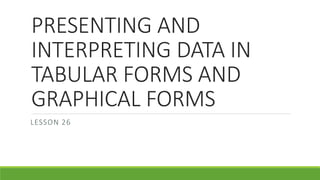
Lesson 26 presenting and interpreting data in tabular and graphical froms
- 1. PRESENTING AND INTERPRETING DATA IN TABULAR FORMS AND GRAPHICAL FORMS LESSON 26
- 2. INTRODUCTION To be able to create and present an organized picture of information from a research report, it is important to use certain techniques to communicate findings and interpretations of research studies into visual form. The common techniques being used to display results are tabular, textual and graphical methods.
- 3. TEXTUAL PRESENTATION OF DATA Textual presentation use words, statements or paragraphs with numerals, numbers to describe data. Example: ◦ There are 42, 036 barangays in the Philippines. The largest barangay in terms of population size in Barangay 176 in Caloocan City with 247 thousand persons. It is followed by Commonwealth in Quezon City (198, 295) and Batasan Hills in Quezon City (161, 409). Twelve other barangays posted a population size of more than a hundred thousand persons.
- 4. Tabular Presentation of Data Tables present clear and organized data. A table must be clear and simple but complete. A good table should include the following parts. Table number and title –these are placed above the table. The title is usually written right after the table number. Caption subhead –this refers to columns and rows. Body –it contains all the data under each subhead. Source- it indicates if the data is secondary and it should be acknowledge.
- 5. Example of a good table Table 1 Ages of individuals in Various Employment Sectors Employment Sector 18-25 Age Group 26-35 Age Group 36-45 Age Group Agriculture 3 8 12 Education 10 15 15 Health 15 28 35 Law 3 5 6 Manufacturing 15 23 32 Retail 30 12 8 Others 25 16 10
- 6. Tabular Presentation with Textual Analysis Table 2 Profile of Students According to Gender Gender Frequency Percentage Male 120 40% Female 180 60% Total 300 100% Analysis: Among 300 respondents, 120 (40% are males and 180 (60% are females)
- 7. Graphical Method of Presenting the Data A graph or chart portrays the visual presentation of data using symbols such as lines, dots, bars or slices. It depicts the trend of a certain set of measurements or shows comparison between two or more sets of data or quantities.
- 8. Line graph A line graph is a graphical presentation of data that shows a continuous change or trend. It may show an ascending or descending trend. 0 1 2 3 4 5 6 7 8 9 2002 2004 2006 2008 2010 2012 2014 2016 2018 2020 Population Population
- 9. Bar Graph A bar graph uses bars to compare categories of data. It may be drawn vertically or horizontally. A vertical bar graph is best to use when comparing means or percentages between distinct categories. The categories are measured independently and compared with one another. A horizontal bar graph may contain more than 5 categories. A bar graph is plotted on either the x-axis or y-axis.
- 10. Vertical Bar Graph 0 5 10 15 20 25 30 35 40 Facebook Twitter YouTube Flicker Number of Users Number of Users
- 11. Pie Charts or Circle Graphs A pie chart is usually used to show how parts of a whole compare to each other and to the whole. The entire circle represents the total and the parts are proportional to the amount of the total they represent.
- 12. COMELEC REGISTRANTS by Age Group COMELEC REGISTRANTS 18-21 22-30 31-39 40-48